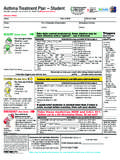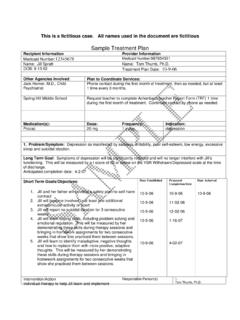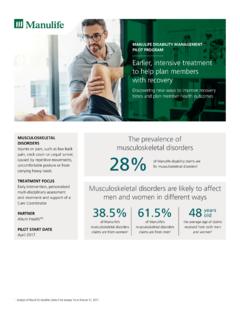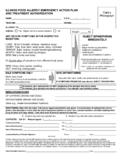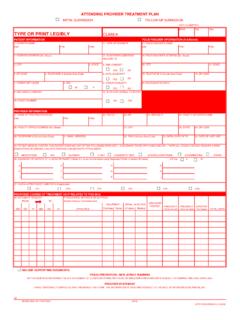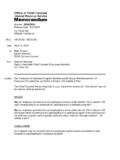Transcription of DEPARTMENT OF THE TREASURY
1 1[4830-01-u] DEPARTMENT OF THE TREASURYI nternal revenue Service26 CFR Part 1[TD 8921]RIN 1545-AY23 Tax treatment of Cafeteria PlansAGENCY: internal revenue Service (IRS), : Final : This document contains final regulations relating to section 125 cafeteriaplans. The final regulations clarify the circumstances under which a cafeteria plan maypermit an employee to change his or her cafeteria plan election with respect to accidentor health coverage, group-term life insurance coverage, dependent care assistanceand adoption assistance during the plan : Effective Date: These regulations are effective January 10, Date: See the Scope of Regulations and Effective Date portion of this FURTHER INFORMATION CONTACT: Christine L. Keller or Janet A. Laufer at(202) 622-6080 (not a toll-free number). Section 125(f) provides that the following are not qualified benefits (even though they1are generally excludable from gross income under an express provision of the InternalRevenue Code): products advertised, marketed, or offered as long-term careinsurance; medical savings accounts under section 106(b); qualified scholarshipsunder section 117; educational assistance programs under section 127; and fringebenefits under section INFORMATION: Background This document contains amendments to the Income Tax Regulations (26 CFR part 1) under section 125 of the internal revenue Code (Code).
2 Section 125 generallyprovides that an employee in a cafeteria plan will not have an amount included in grossincome solely because the employee may choose among two or more benefitsconsisting of cash and qualified benefits. A qualified benefit generally is any benefitthat is excludable from gross income under an express provision of the Code, includingcoverage under an employer-provided accident or health plan under sections 105 and106, group-term life insurance under section 79, elective contributions under a qualifiedcash or deferred arrangement within the meaning of section 401(k), dependent careassistance under section 129, and adoption assistance under section 137. Qualified1benefits can be provided under a cafeteria plan either through insured arrangements orarrangements that are not insured. 49 FR 19321 (May 7, 1984) and 54 FR 9460 (March 7, 1989), TD 8878 at 65 FR 15548 (March 23, 2000). These final regulations were preceded by3 temporary regulations issued in 1997.
3 See 62 FR 60196 (November 7, 1997) and 62FR 60165 (November 7, 1997). REG-117162-99 at 65 FR 15587 (March 23, 2000).43In 1984 and 1989, proposed regulations were published relating to cafeteriaplans. In general, the 1984 and 1989 proposed regulations require that, for benefits to2be provided on a pre-tax basis under section 125, an employee may make changesduring a plan year only in certain circumstances. Specifically, Q&A-8 of ' andQ&A-6(b), (c), and (d) of ' permit participants to make benefit election changesduring a plan year pursuant to changes in cost or coverage, changes in family status,and separation from 2000, final regulations were issued permitting a participant in a cafeteria plan3to change his or her accident or health coverage election during a period of coveragein specific circumstances such as where special enrollment rights arise under section9801(f) (added to the Code by the Health Insurance Portability and Accountability Actof 1996 (HIPAA)(110 Stat.))
4 1936), where eligibility for Medicare or Medicaid is gained orlost, or where a court issues a judgment, decree, or order requiring that an employee=schild or foster child who is a dependent receive health coverage. In addition, the finalregulations permit an employee to change his or her accident or health coverageelection or group-term life insurance election if certain change in status rules aresatisfied. On the same day that the final regulations were issued, proposed regulations4 For example, an employee might seek to increase group-term life insurance due to a5marriage (because of the need to provide income to the new spouse in the event thatthe chief wage-earner dies) or to decrease group-term life insurance due to a marriage(because the new spouse may be a wage-earner who can support the family in theevent that the employee dies).4were also issued containing change in status rules that apply to other types of qualifiedbenefits ( , dependent care assistance and adoption assistance) and describing thecircumstances under which changes in the cost or coverage of qualified benefitsprovide a basis for changes in cafeteria plan elections.
5 The IRS and TREASURY receivedwritten comments on the proposed regulations and held a public hearing on August 17,2000. Having considered the comments and the statements made at the hearing, theIRS and TREASURY revise the final regulations and adopt the proposed regulations asmodified by this TREASURY decision. The comments and revisions are discussed of Provisions1. Changes in the March 2000 Final RegulationsWith respect to group-term life insurance and disability coverage, the finalregulations issued earlier this year provided flexibility by stating that, in the event of achange in an employee=s marital status or a change in the employment status of theemployee=s spouse or dependent, an employee may elect either to increase suchcoverage or to decrease such coverage. Commentators recommended that this rule5also apply in the case of birth, adoption, placement for adoption, or death. Theargument was made that in these other situations -- because these types of coverageare generally designed to provide income, instead of expense reimbursements -- it may5be appropriate for the employee to seek to increase or decrease the coverage.
6 Inaccordance with these recommendations and in the interest of simplicity, the finalregulations have been modified to allow participants to increase or decrease thesetypes of coverage for all change of status events. Further, as also suggested bycommentators, the final regulations have been modified to expand the rule to apply tocoverage to which section 105(c) (which is coverage for permanent loss or loss of useof a member or function of the body) applies. Commentators requested clarification as to how the election change rules withrespect to special enrollment rights under section 9801(f) (enacted under HIPAA) applyto a participant who marries if the group health plan allows the participant to change hisor her health coverage election retroactively to the date of the marriage. In response tothis comment, language has been added to an example in the final regulations to clarifythat an election change can be funded through salary reduction under a cafeteria planonly on a prospective basis, except for the retroactive enrollment right under section9801(f) that applies in the case of an election made within 30 days of a birth, adoption,or placement for respect to accident or health coverage, the consistency rule in the finalregulations requires that any employee who wishes to decrease or cancel coveragebecause he or she becomes eligible for coverage under a spouse=s or dependent=splan due to a marital or employment change in status can do so only if he or sheactually obtains coverage under that other plan.
7 Commentators requested clarificationas to the type of proof an employer must receive to satisfy this rule, expressing concern6that a plan could not implement a change on a timely basis because of a need to obtainproper proof of the other coverage. An example in the final regulations has beenrevised to make it clear that employers may generally rely on an employee=s certification that the employee has or will obtain coverage under the other plan(assuming that the employer has no reason to believe that the employee certification isincorrect ). The final regulations allow a participant to change his or her election if ajudgment, decree or order resulting from a divorce, legal separation, annulment, orchange in legal custody requires that an employee s spouse, former spouse, or otherindividual provide accident or health coverage for the employee s child or for a fosterchild who is a dependent of the employee. The final regulations were modified toclarify that the participant can only change his or her election if the spouse, formerspouse, or other individual actually provides accident or health coverage for the Changes From the March 2000 Proposed RegulationsThe final regulations being issued today are generally consistent with theproposed regulations that were issued earlier this year, but include and coverage rulesThe proposed regulations included rules allowing election changes inconnection with a significant increase in cost or a significant curtailment in coverage,irrespective of whether the plan is insured or not insured.
8 These cost and coveragerules (and the other rules in paragraph (f) of ' ) do not apply with respect toA flexible spending arrangement (FSA) is defined in section 106(c)(2). Under section6106(c)(2), an FSA is generally a benefit program under which the maximumreimbursement reasonably available for coverage is less than 500% of the value of thecoverage. A health FSA is an accident or health plan that is an under a health FSA. However, all of the rules in paragraphs (a) through (e)6and paragraph (g) of the final regulations under ' do apply with respect tocoverage under a health FSA. One modification reflected in the final regulations is toclarify that the cost increase rules apply when the amount of an employee s electivecontributions under section 125 increases either due to the employee contributing alarger portion of the total cost of the qualified benefits plan (which might occur, forexample, if part-time employees pay a larger portion of a plan=s cost and the employeeswitches to part-time status) or due to an increase in the total cost of the qualifiedbenefits plan.
9 In response to comments, modifications were also made to allow electionchanges during a period of coverage when there is a significant decrease in the cost ofa qualified benefits plan or in the cost of a benefits package option under the qualifiedbenefits plan, as well as when there is a significant increase. Under the regulations asmodified, if there is a significant decrease in the cost of a qualified benefits plan duringthe plan year, the final regulations permit a cafeteria plan to allow all employees, eventhose who have not previously participated in the cafeteria plan, to elect to participatein the qualified benefits plan through the cafeteria plan. Similarly, if there is asignificant decrease in the cost of a benefits package option during the plan year, thefinal regulations permit a cafeteria plan to allow all eligible employees to elect that8option (including employees who have elected another option, as well as those whohave not previously participated in the cafeteria plan).
10 Further, in response to comments, modifications were also made to allowmidyear election changes when there is a significant improvement in the coverageprovided under a benefit package option, as well as when there is a new benefitpackage option offered under the plan. Commentators also requested clarification as to whether a cafeteria plan couldallow participants to drop coverage in response to a significant change in the cost orcoverage of a qualified benefit. The final regulations clarify this issue, and provide that,if there is no other similar coverage, employees may drop coverage (including achange from family to single coverage) in response either to an increase in the cost ofa qualified benefit or to a loss of coverage. The regulations also permit an employee toelect similar coverage in response to a significant curtailment in coverage. However,the regulations do not allow an employee to drop coverage altogether if there is asignificant curtailment in coverage that does not constitute a loss of coverage.










